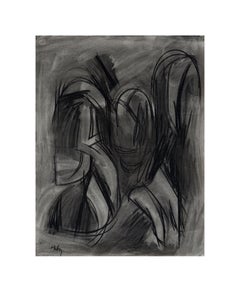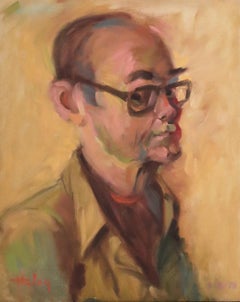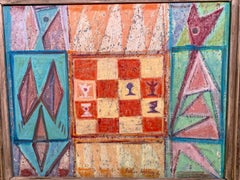John Charles Haley
1950s Abstract Expressionist Abstract Drawings and Watercolors
Charcoal, Graphite, Paper
Recent Sales
1970s American Modern Portrait Paintings
Canvas, Acrylic
Mid-20th Century Analytic Cubist Abstract Paintings
Canvas, Oil
People Also Browsed
21st Century and Contemporary Russian Brutalist Benches
Oak
21st Century and Contemporary French Modern Chairs
Steel
1950s Cubist Abstract Paintings
Oil
Early 20th Century Cubist Figurative Drawings and Watercolors
Paper, Charcoal
Antique 16th Century Thai Sculptures
Sandstone
2010s Abstract Expressionist Paintings
Canvas, Oil, Graphite
21st Century and Contemporary Abstract Abstract Paintings
Glass, Paper, Acrylic, Wood, Oil Pastel
1950s Abstract Abstract Paintings
Canvas, Oil
1930s Art Deco Nude Drawings and Watercolors
Ink
1970s American Modern Figurative Paintings
Canvas, Oil, Stretcher Bars
1990s Abstract Abstract Paintings
Canvas, Oil
Mid-20th Century Abstract Landscape Paintings
Masonite, Acrylic
21st Century and Contemporary Modern Nude Sculptures
Bronze
1990s Abstract Geometric Abstract Paintings
Canvas, Acrylic, Gouache
1970s Abstract Expressionist Abstract Paintings
Acrylic, Laid Paper
1950s Modern Figurative Drawings and Watercolors
Charcoal, Pencil
John Haley for sale on 1stDibs
John Charles Haley was born September 21, 1905, in Minneapolis, Minnesota. As a teenager, he was already adept at line drawing and was regularly publishing cartoons and comic strips in his high school's weekly newspaper. After graduating from high school, Haley decided to enroll at the Minneapolis School of Art for four years. In Minnesota during the 1920s a conservative manner of painting was the only available style for Haley. John Charles Haley received formal training in the nineteenth century Beaux-Arts tradition, and was commissioned to paint a portrait of a lumber tycoon from Minneapolis. The portrait of T.B. Walker, who founded the Walker Art Center, was hung in the Hall of Fame at City Hall after it was completed. Haley graduated from the Minneapolis School of Art in 1927 (Ghent 11).
Haley received the Ethel Morrison Van Derlip scholarship before graduating that allowed him to travel to Europe and study for a year. After receiving the scholarship and commission from T.B. Walker, John Charles Haley was beginning to gain recognition as an up and coming artist. In 1927, Haley traveled to Europe with his mentor Cameron Booth to make his first trip to the art capitals of the world. Haley went to Paris first and met fellow Minneapolis School of Art teacher Vaclav Vytlacil (1892-1984) who encouraged him to study under German modernist master Hans Hoffman (1880-1966). He then went to Munich and studied under Hofmann, and quickly absorbed the master's cubist forms, soon establishing himself as one of Hofmann's most outstanding students ("John Charles Haley"). This influential teacher molded Haley's style of painting, which Haley took back to the United States in 1928 (Ghent 12).
Upon his return, Haley married his childhood sweetheart, Monica Phares, who shared his passion for art throughout their lives together. He returned to the Minneapolis School of Art as a teacher, but did not stay in Minnesota for long. Haley and his wife moved to California after a recommendation from several artists opened the door to a teaching position at the University of California, Berkeley. They settled in the San Francisco Bay area, and John taught at U.C. Berkeley for forty-two years before retiring. Haley joined the Art Department to support the study and practice of modern art, and quickly impressed his colleagues (Ghent 14). George Krevsky wrote, "Haley is credited with building one of the strongest art departments in the country at the University of California at Berkeley and influencing generations of artists such as Elmer Bischoff, Paul Wonner and Stephen de Staebler" ("John Haley"). The addition of Haley to the Berkeley staff helped facilitate the introduction of modern art to the Bay Area.
The first exhibition of Haley's work in California occurred at the Mills College Gallery in November of 1931. The title of the group exhibition was "The Complete Development of Modern Painting: from Manet to Hans Hofmann" and showcased the talent of Haley's work. His first solo show was at The Art Center in San Francisco in which he showed 19 watercolors and temperas. Along with the solo show came positive reviews from art critics. Haley was quickly becoming recognized for his work in the Bay area and soon exhibited his work throughout the country.
In 1943, Haley was drafted into the United States Naval Reserve. His talent at drawing landscapes did not go unnoticed, and he drew every detail of the surrounding areas for invasion strategies. Haley was sent to Normandy, Sicily and the Pacific Islands. After a year in Europe, he was promoted to Lieutenant and stationed in Guam, where he spent his remaining time in the military. Haley returned to U.C., Berkeley, in 1945 after an honorable discharge from the military. Upon his return, he heard of a new abstract way of painting and spent five years experimenting in different styles. He began to spend his summers in the American southwest, frequenting Arizona and New Mexico. He found great stimulation and inspiration from the geography of these states, and expressed it in his art.
Throughout his life, Haley experimented with different styles of painting and excelled in all aspects. He occasionally worked in sculpture. He retired from teaching in 1972 after building an impressive reputation as a teacher, mentor and artist. Haley passed away in 1991 after inspiring students and artists alike.


